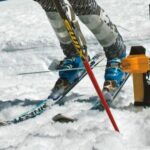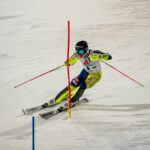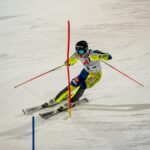I obviously believe in the ability of the mind to power your ski racing efforts. At the same time, I can’t say that the mind is the most important contributor to ski racing success. The reality is that all of the mental skills in the world won’t help you if you’re not physically capable of getting down the hill. So, an essential step in getting ready for training and races is to know your prime intensity.
As I mentioned in my article two weeks ago, prime intensity is the ideal amount of physiological activity necessary for you to ski your best. It’s also the level of intensity that you perceive as most positive and beneficial to your ski racing. Unfortunately, there is no one ideal level of intensity for every racer. Prime intensity is individual; it’s different for everyone. Some racers ski best relaxed. Others ski best energized, but not too psyched up. Still others ski best unbelievably intense and fired up. You must find out the level of intensity that enables you to ski your best.
Your intensity is much like the thermostat maintaining the most comfortable temperature in your house. You always notice when your house is too warm or too cold because you’re sensitive to changes in temperature. When the temperature becomes uncomfortable, you adjust the thermostat to a more comfortable level. You can think of your intensity as your internal temperature that needs to be adjusted periodically. You need to be sensitive to when your intensity is no longer comfortable, in other words, it’s not allowing you to ski your best. You can then use intensity-control techniques to help you to raise or lower your intensity to its prime level.
You have several goals in developing prime intensity. First, to learn what is your prime intensity. Then, to recognize the signs of overintensity and underintensity in training and races. Finally, to take active steps to reach and maintain prime intensity throughout training and races.
Compare Races for Prime Intensity
The first step in taking control of your intensity is to identify what is your prime intensity. First, think back to recent races in which you skied really well. Recall your level of intensity. Were you relaxed, energized, or really fired up? Then remember the thoughts, emotions, and physical feelings you experienced before during these races. Were you positive or negative, happy or angry, relaxed or tense? Also, think back to what the race situation was and what you did to feel that prime level of intensity.
Second, think back to recent races in which you skied poorly. Recall your level of intensity. Remember the thoughts, emotions, and physical feelings you had in these races. And think back to what the race situation was and what you did before the races to feel that non-prime level of intensity.
If you’re like most racers, a distinct pattern will emerge. When you ski well, you have a particular level of intensity. This is your prime intensity. There are also common thoughts, emotions, and physical feelings associated with your prime intensity and skiing well. Additionally, the particular race situation may have led to that specific level of intensity and you probably did certain things before races to get in that prime state of intensity.
In contrast, when you’re skiing poorly, there is a very different level of intensity, either higher or lower than your prime intensity. There are also decidedly different thoughts, emotions, and physical feelings. And there was likely something about the particular race situation and what you did that caused the non-prime intensity.
Experiment in Training
Another useful way to help you understand your prime intensity is to experiment with different levels of intensity in training and see how the differing intensity impacts your skiing. Here’s a good exercise you can use to learn more about your prime intensity.
Let’s say you’re going to take nine runs of slalom in a training session. Break up the session into three segments. The first segment will emphasize low intensity. Before you begin this set of training runs, take several slow, deep breaths, relax your muscles, and focus on calming thoughts (e.g., “Easy does it,” “Cool and calm.”). As you start these runs, stay focused on keeping your mind and body calm and relaxed.
The second segment of training will focus on moderate intensity. Before this set of training runs, take a few deep, but more forced breaths, move around a bit, and focus on more energetic thoughts (e.g., “Let’s go,” “Pick it up.”). Before these training runs, jump around lightly and feel your intensity picking up. As you begin these runs, pay attention to feeling the increased intensity and energy in your mind and body.
The final segment of training runs will highlight high intensity. Before this set of training runs, take several shorter, more intense breaths with special emphasis on a hard and aggressive exhale, do some high-intensity jumps, and repeat intense thoughts (e.g., “Fire it up!,” “Get after it!”), saying these out loud with energy. Feel the high level of intensity and energy at the start of these runs and focus on maintaining the intensity with high-energy self-talk throughout the runs.
I encourage you to use this exercise for several days so you can see clearly how your intensity impacts your skiing. As with comparing past good and poor races, you will likely see a pattern emerge in which you ski better at one of the three levels of intensity. That level of intensity is the one you want to aim for in both training and races.
With this knowledge, you will have a good sense of your prime intensity. You can then use that information to recognize when you’re not at prime intensity in training and before races. You will then be ready to take active steps to adjust your intensity to a prime level, thus increasing your readiness to ski consistently fast in training and races.
In future articles, I’ll show you psych-up and psych-down techniques you can use to achieve your prime intensity.
Note: I will be conducting a webinar on Positive Pushing: How to Raise a Successful and Happy Child on Wednesday, November 16th, at 7 pm Mountain time. 20% of the proceeds will be donated to your USSA club. To learn more, contact Kevin Ward at kward@glcollaboration.com or 800-839-9976.






